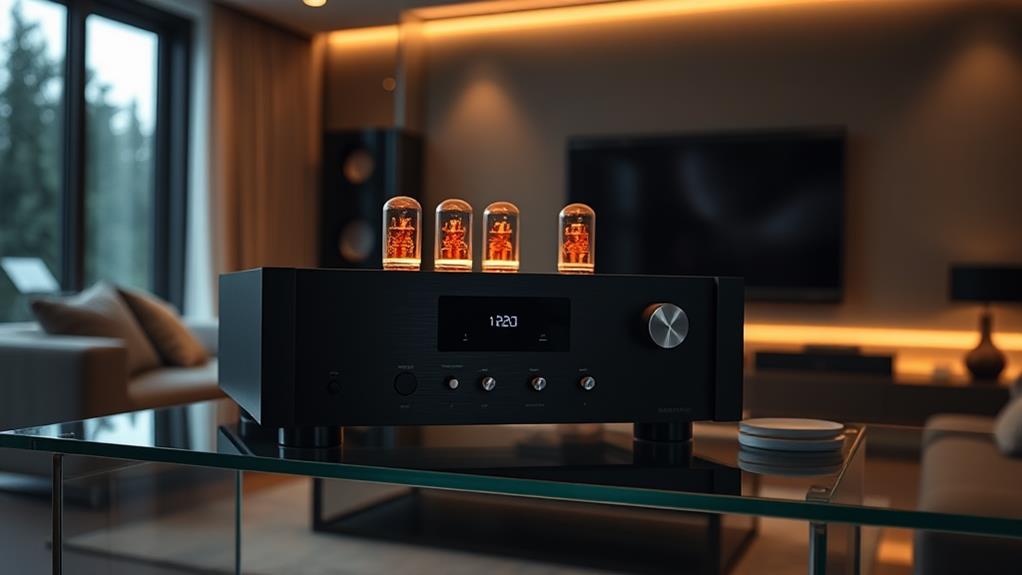When selecting a high-performance audio amplifier for your home theater system, you’ll need to evaluate several key factors. These include power output, impedance matching, connectivity options, and amplifier class.
You should choose an amplifier with sufficient wattage for your speakers and room size, ensuring proper impedance compatibility. Look for models with low distortion levels and a wide frequency response range. Assess whether you need a multichannel amplifier for surround sound or a stereo setup for music.
Proper placement and ventilation are essential for peak performance. By understanding these elements, you’ll be better equipped to make an informed decision that enhances your audio experience. Exploring each aspect in detail will further refine your selection process.
Main Points
- Understand amplifier basics: power output, frequency response, and total harmonic distortion for informed selection.
- Choose between integrated amplifiers, separate components, or AV receivers based on your system needs.
- Match amplifier power output to speaker requirements and room size for optimal performance.
- Consider connectivity options, including analog, digital, and wireless inputs for versatile audio source integration.
- Select the appropriate amplifier class (A, AB, or D) based on sound quality preferences and efficiency requirements.
Understanding Audio Amplifier Basics
Audio amplifiers are essential components in any sound system, boosting weak electrical signals to drive speakers and produce audible sound. They take low-level signals from sources like turntables, CD players, or streaming devices and increase their power to a level that can move speaker drivers effectively.
You’ll find amplifiers in various audio setups, from simple stereo systems to complex home theaters. When choosing an amplifier, it’s important to take into account factors such as power output and compatibility with your existing speakers to guarantee peak performance.
The basic function of an amplifier involves several stages. First, there’s the input stage, where the weak signal enters. Next, the voltage amplification stage increases the signal’s amplitude. Then, the driver stage prepares the signal for the output stage, which delivers the high-current signal to the speakers.
Most modern amplifiers use solid-state technology, employing transistors or integrated circuits. However, some audiophiles prefer tube amplifiers for their perceived warmer sound.
Key specifications you’ll encounter when exploring amplifiers include power output (measured in watts), frequency response, and total harmonic distortion (THD). These metrics help determine an amplifier’s performance and suitability for your specific needs.
Understanding these basics will help you make informed decisions when selecting an amplifier for your audio system.
Types of Home Theater Amplifiers
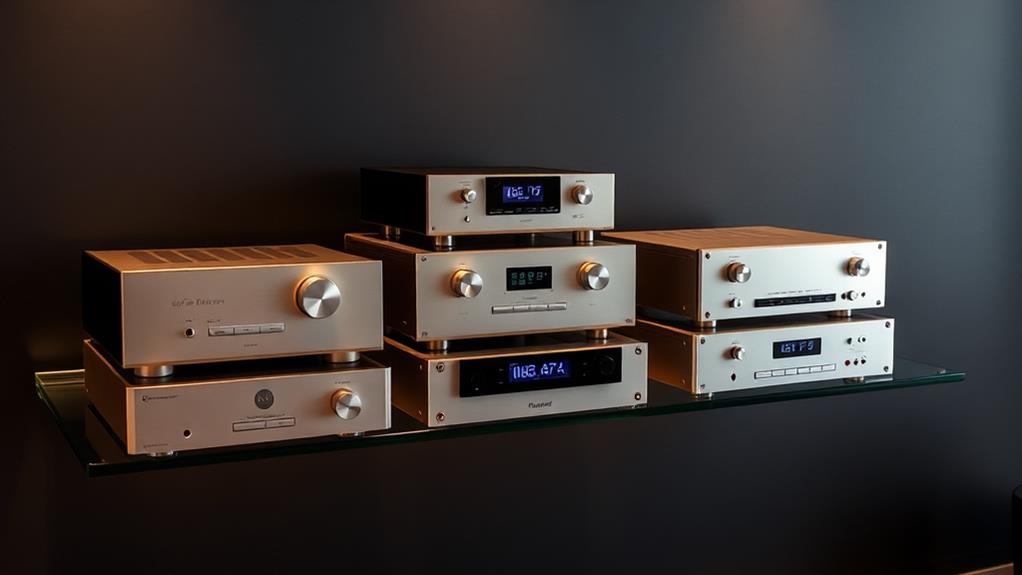
Home theater enthusiasts’ amplifier choices typically fall into three main categories: integrated amplifiers, separate components, and AV receivers. Integrated amplifiers combine a preamplifier and power amplifier in one unit, offering a space-saving solution with fewer cables. They’re ideal for those who want simplicity without sacrificing sound quality.
Separate components, on the other hand, consist of individual preamplifiers and power amplifiers. This configuration allows for greater flexibility and potential for upgrades, as you can mix and match components to suit your preferences. For those looking to elevate their sound, exploring top audio amplifier products can greatly enhance the home theater experience.
AV receivers are the most common choice for home theater setups. They integrate amplification, audio processing, and video switching in a single device. Most receivers offer multi-channel amplification, typically 5.1 or 7.1 channels, to power surround sound systems. They also include various inputs and outputs, making them versatile for connecting multiple audio and video sources.
Advanced features like room correction, network streaming, and support for object-based audio formats (e.g., Dolby Atmos) are often included. When choosing an amplifier type, consider your space constraints, budget, and desired level of customization.
Power Output and Wattage Explained
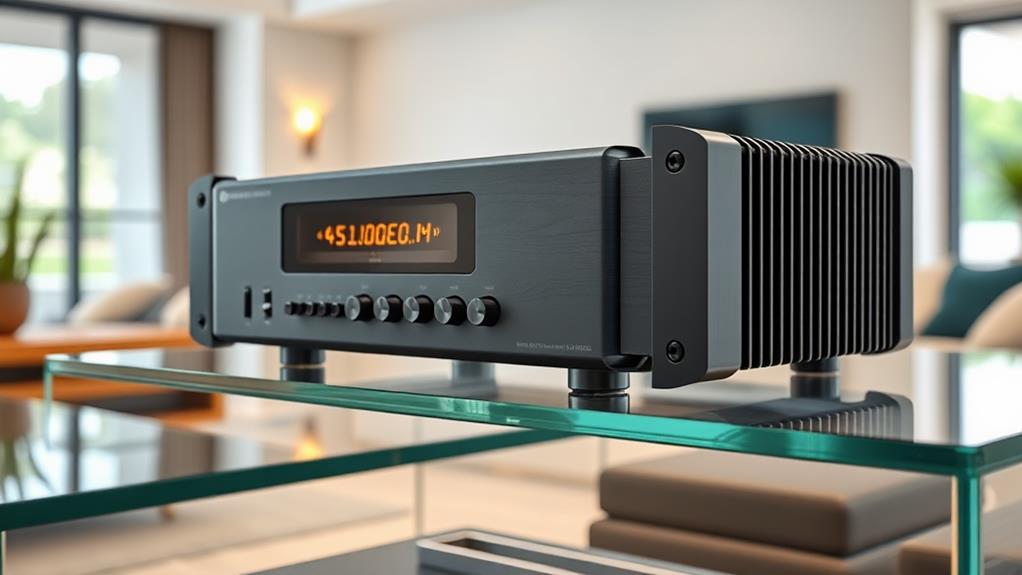
When considering amplifiers, power output, and wattage are often misunderstood yet vital factors. Power output, measured in watts, indicates an amplifier’s capacity to drive speakers. It’s essential to understand that more watts don’t always equate to better sound quality.
Instead, wattage relates to an amplifier’s ability to produce volume without distortion. While home theater systems typically require more power, headphone amplifiers often operate at lower wattages due to the different requirements of headphones compared to speakers.
You’ll encounter two main wattage specifications: RMS (Root Mean Square) and peak power. RMS represents the continuous power an amplifier can sustain, while peak power indicates short-term maximum output. For home theater use, focus on RMS ratings as they’re more relevant to real-world performance.
The power you need depends on your room size, speaker efficiency, and listening preferences. In a typical living room, an amplifier with 50-100 watts per channel is often sufficient. However, larger spaces or less efficient speakers may require more power. It’s important to match your amplifier’s output to your speakers’ power handling capabilities to avoid damage. Remember, doubling the wattage only increases volume by about 3 decibels, a barely noticeable difference to the human ear.
Impedance and Speaker Matching
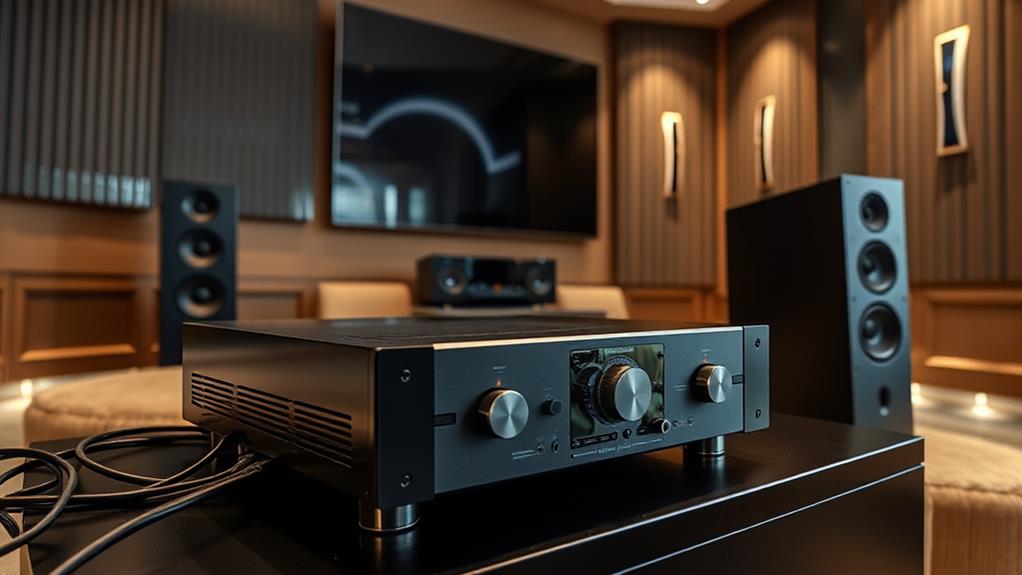
An amplifier’s performance isn’t solely determined by its power output; impedance matching plays an essential role in enhancing sound quality and preventing damage to your equipment. Impedance, measured in ohms, represents the resistance to electrical current flow in your audio system.
Most home theater speakers have an impedance rating of 4, 6, or 8 ohms, while amplifiers are designed to work with specific impedance ranges. When setting up your system, it’s vital to take into account the audio interface connecting your PC to the amplifier, as it can affect the overall sound quality and impedance matching.
When selecting speakers for your amplifier, keep in mind these key points:
- Mismatched impedance can lead to distorted sound or overheating
- Lower-impedance speakers draw more current from the amplifier
- Higher impedance speakers reduce power output but are generally safer
- Some amplifiers can handle a range of speaker impedances
To guarantee proper matching, check your amplifier’s specifications for its recommended speaker impedance range. It’s generally safe to use speakers with a higher impedance than the amplifier’s minimum rating, but using lower-impedance speakers can strain the amp.
Many modern amplifiers have protection circuits to prevent damage from mismatched loads, but it’s best to avoid pushing these limits. By carefully matching your amplifier and speakers, you’ll achieve peak performance and longevity from your audio system.
Connectivity Options for Amplifiers
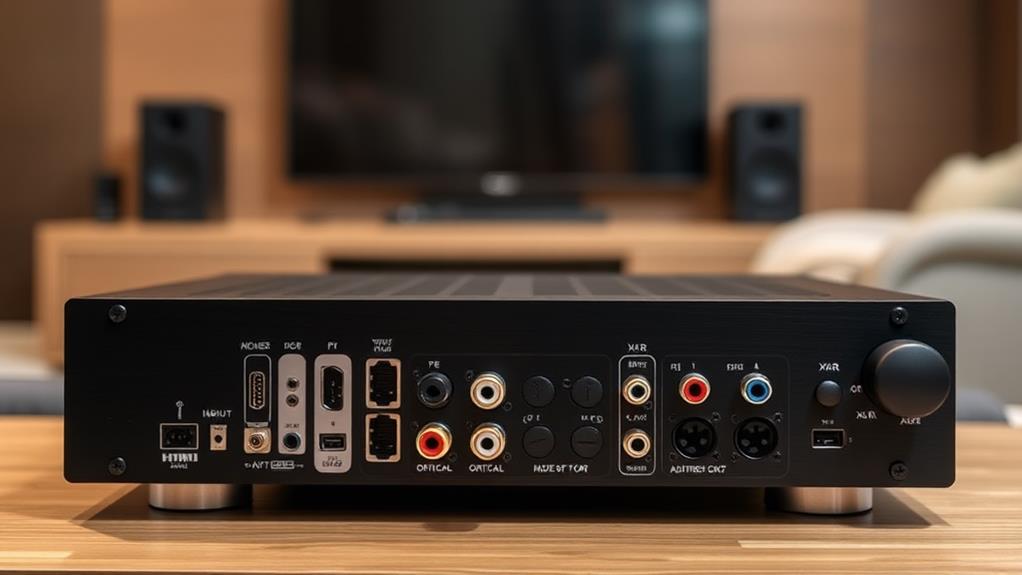
Modern amplifiers come with a variety of connectivity options to suit different audio sources and setups. You’ll typically find both analog and digital inputs on high-performance amplifiers. Analog inputs include RCA connectors, which are common for stereo connections, and XLR connectors, which are balanced inputs often used in professional audio equipment.
These analog inputs allow you to connect traditional audio sources like CD players or turntables. When it comes to connecting your amplifier to a laptop, audio interfaces can provide additional flexibility and improved sound quality for recording and playback.
For digital connections, you’ll see options like optical (TOSLINK) and coaxial inputs. These allow you to connect digital audio sources, such as streaming devices or Blu-ray players, directly to the amplifier. Some amplifiers also feature USB inputs for connecting computers or other digital devices.
HDMI inputs and outputs are becoming more common, especially in home theater amplifiers, as they can carry both high-quality audio and video signals.
Many modern amplifiers now include wireless connectivity options. You’ll find features like Bluetooth for easy pairing with smartphones or tablets, and Wi-Fi for network streaming and multi-room audio setups.
Some amplifiers also support proprietary wireless audio protocols developed by specific manufacturers. These connectivity options guarantee that your amplifier can integrate seamlessly with a wide range of audio sources and home entertainment systems.
Distortion and Signal-to-Noise Ratio

Understanding distortion and signal-to-noise ratio (SNR) is vital when evaluating high-performance audio amplifiers. Distortion refers to any unwanted alteration of the original audio signal, while SNR measures the level of the desired signal compared to background noise. When selecting an amplifier, you’ll want to look for low distortion and high SNR values to guarantee the clearest sound reproduction possible.
- Total Harmonic Distortion (THD): Measures the amount of harmonic frequencies added to the original signal
- Intermodulation Distortion (IMD): Occurs when two or more frequencies interact, creating new, unwanted frequencies
- Signal-to-Noise Ratio (SNR): Expressed in decibels (dB), higher values indicate cleaner sound
- Dynamic Range: The difference between the quietest and loudest sounds an amplifier can reproduce
Manufacturers often specify THD and SNR in their product specifications. A high-quality amplifier typically has a THD of less than 0.1% and an SNR of 100 dB or higher. However, it is significant to mention that these measurements don’t always correlate directly with perceived sound quality.
Other factors, such as the amplifier’s design and components, also play key roles in overall performance. When comparing amplifiers, consider listening tests alongside technical specifications to make an informed decision.
Multichannel vs. Stereo Amplifiers
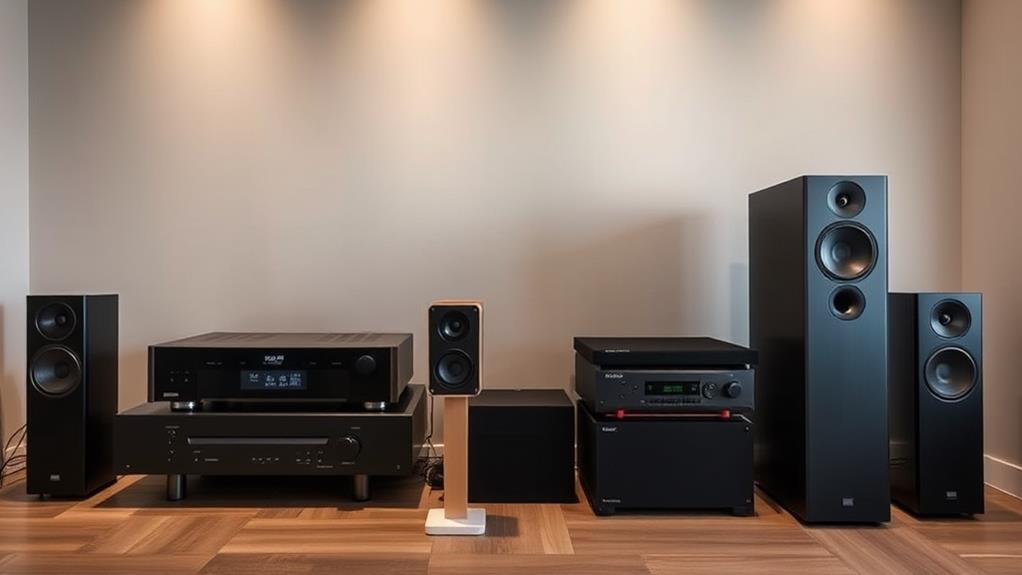
When selecting a high-performance audio amplifier, you’ll need to decide between multichannel and stereo options. Stereo amplifiers, as the name suggests, power two channels: left and right. They’re ideal for music-focused setups and traditional two-speaker systems. Multichannel amplifiers, on the other hand, support three or more channels, making them suitable for home theater systems with surround sound.
Multichannel amplifiers typically offer five or seven channels, corresponding to 5.1 or 7.1 surround sound configurations. The “.1” refers to a subwoofer channel for low-frequency effects. These amplifiers provide immersive audio experiences for movies and games, but they’re often more complex and expensive than stereo models. Stereo amplifiers, while simpler, can deliver higher power per channel and are often preferred by audiophiles for music reproduction.
Your choice will depend on your primary use case and room setup. If you’re building a home theater, a multichannel amplifier is essential. For a dedicated music listening room, a high-quality stereo amplifier might be the better option. Some enthusiasts even combine both types, using a multichannel amp for surround speakers and a separate stereo amp for the main front speakers.
Class A, AB, D Amplifiers

Delving into the world of amplifier classes reveals three main categories: Class A, Class AB, and Class D. Each class offers unique characteristics that impact sound quality, efficiency, and heat generation.
Class A amplifiers are known for their superior sound quality but low efficiency, while Class AB strikes a balance between sound quality and efficiency. Class D amplifiers, on the other hand, offer high efficiency but may sacrifice some audio fidelity.
When choosing an amplifier for your home theater system, consider these factors:
- Power output requirements for your speakers
- Room size and acoustics
- Heat dissipation capabilities of your setup
- Budget constraints and long-term energy costs
Class A amplifiers operate with the output devices conducting continuously, resulting in minimal distortion but high power consumption. Class AB combines elements of Class A and B, offering improved efficiency while maintaining good sound quality. Class D amplifiers use pulse-width modulation to achieve high efficiency, making them ideal for compact systems or situations where heat dissipation is a concern. However, they may introduce high-frequency noise that requires careful filtering.
Understanding these differences will help you select the amplifier that best suits your needs and preferences.
Amplifier Placement and Ventilation
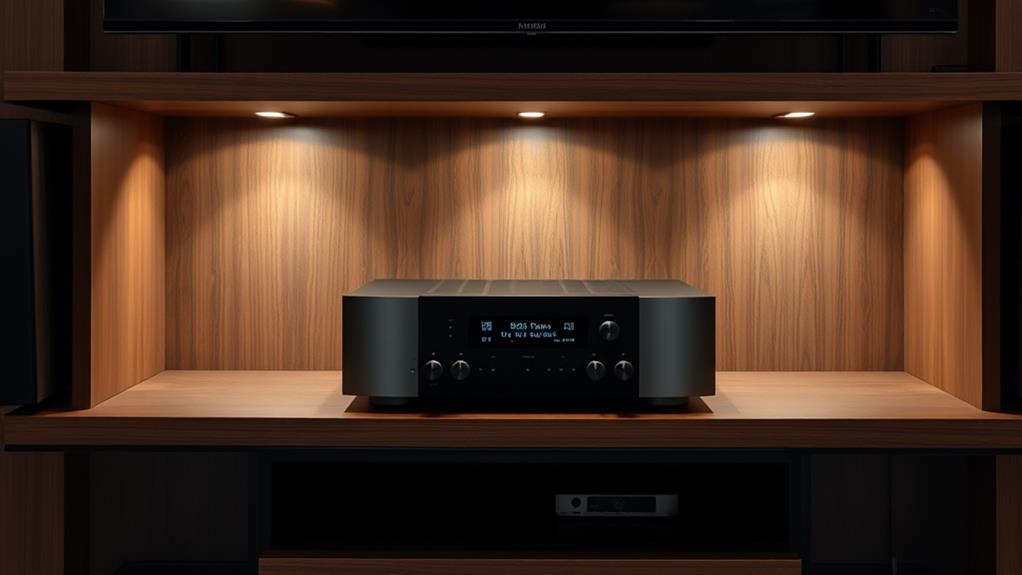
Having chosen the right amplifier class for your needs, you’ll need to evaluate its placement and ventilation. Proper positioning and airflow are essential for maintaining peak performance and longevity of your audio amplifier.
First, make certain you place the amplifier on a stable, level surface that can support its weight. Avoid stacking other components directly on top of it, as this can impede heat dissipation.
For ventilation, allow at least 3-4 inches of clearance on all sides of the amplifier. This space permits adequate air circulation, preventing overheating. If possible, position the amplifier in an open-sided rack or shelf. Avoid enclosed cabinets unless they’re equipped with active cooling systems.
Many high-performance amplifiers generate significant heat, especially Class A and AB types. If you notice excessive warmth, consider adding a small fan to improve airflow.
Keep the amplifier away from direct sunlight, heating vents, and other heat sources. Dust can accumulate over time, acting as an insulator and reducing cooling efficiency. Regularly clean the amplifier’s vents and surfaces with a soft, dry cloth or compressed air. By following these guidelines, you’ll help guarantee your amplifier operates at prime performance and avoids heat-related issues.
Choosing the Right Amplifier
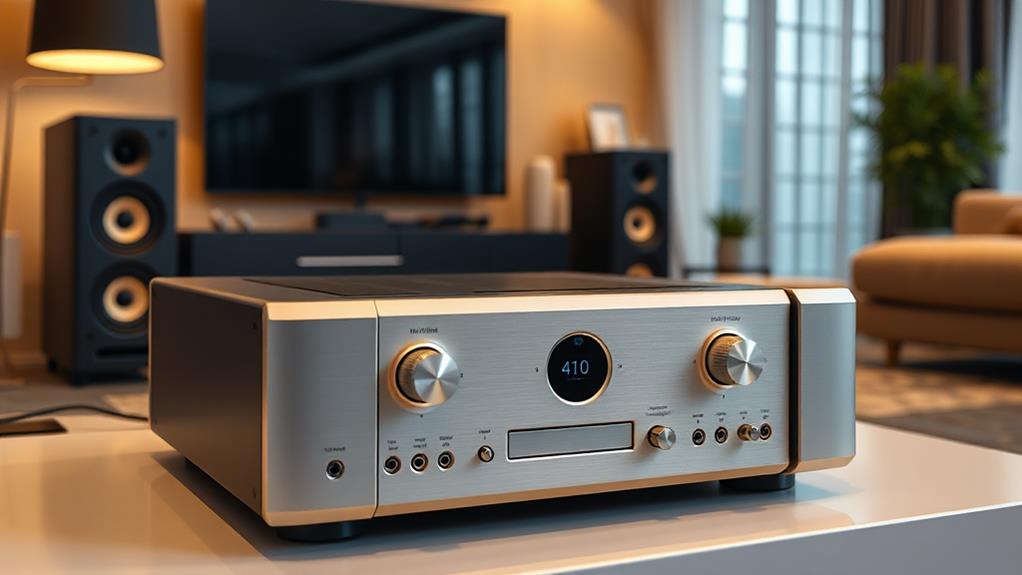
Choosing the right amplifier for your audio setup can seem intimidating at first glance. However, understanding a few key factors can simplify the process and help you make an informed decision.
When selecting an amplifier, take into account your room size, speaker specifications, and desired sound quality. The amplifier’s power output, measured in watts per channel, should match your speakers’ power handling capabilities and efficiency ratings.
Here are four vital aspects to keep in mind when choosing an amplifier:
- Power output: Verify it’s sufficient for your speakers and room size
- Impedance compatibility: Match the amplifier’s output to your speakers’ impedance
- Frequency response: Look for a wide range to reproduce all audible frequencies
- Total harmonic distortion (THD): Lower THD indicates cleaner sound reproduction
Additionally, take into account the amplifier’s connectivity options, such as RCA inputs, balanced XLR connections, or digital inputs. Class A, AB, or D amplifiers offer different benefits regarding efficiency and sound quality. Class D amplifiers, for instance, are more energy-efficient but may sacrifice some audio fidelity.
Finally, evaluate the amplifier’s build quality, including components and heat dissipation capabilities, to guarantee longevity and consistent performance.
Frequently Asked Questions
How Often Should I Upgrade My Home Theater Amplifier?
You don’t need to upgrade your home theater amplifier frequently. Most quality amplifiers can last 10-15 years or more with proper care. However, you might consider upgrading if you notice a decline in sound quality, if your current amplifier can’t support new audio formats, or if you’re expanding your system. Technological advancements, such as improved power efficiency or connectivity options, may also prompt an upgrade. Ultimately, the decision depends on your personal needs and budget rather than a fixed timeline.
Can I Use Professional Audio Amplifiers for My Home Theater System?
You can use professional audio amplifiers for your home theater system, but it’s not always ideal. Pro amps are designed for different environments and may lack features specific to home theater use. They’re often more powerful than necessary and can be challenging to integrate with other components. However, if you’re an audio enthusiast seeking high performance, some pro amps can work well. Consider factors like impedance matching, connectivity options, and room acoustics before making this choice.
Do Amplifiers Require a Break-In Period for Optimal Performance?
You may have heard that amplifiers need a break-in period, but this is largely a myth. While some audiophiles claim to hear improvements over time, there’s little scientific evidence to support this. Modern amplifiers typically perform at their best from the start. Any perceived changes are more likely due to your ears adjusting to the sound or placebo effects. It’s best to focus on proper setup and room acoustics for the best performance from your amplifier.
How Do Room Acoustics Affect Amplifier Selection and Performance?
Room acoustics greatly influence your amplifier’s performance and selection. You’ll need to take into account factors like room size, shape, and materials. Large rooms may require more powerful amplifiers to fill the space adequately. Reflective surfaces can create echoes, affecting sound quality, while absorptive materials can dampen it. You might need an amplifier with room correction technology to compensate for acoustic challenges. Additionally, speaker placement and listening position interact with room acoustics, influencing your amplifier’s effectiveness in delivering ideal sound.
Are There Any Advantages to Using Separate Amplifiers for Different Channels?
You’ll find several advantages to using separate amplifiers for different channels. First, it allows for better power distribution, ensuring each channel receives adequate power. This can improve overall sound quality and clarity. Second, you can customize amplifiers for specific speaker needs, optimizing performance. Third, it reduces interference between channels, potentially lowering distortion. Finally, separate amplifiers offer more flexibility for upgrades and system expansion. However, keep in mind that this approach typically costs more and requires more space.

